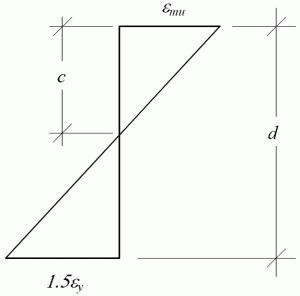Recent decades have seen major changes in methods of structural design and analysis. The allowable stress approach was applied to all materials for decades until, many years ago, the principles of strength design for reinforced concrete were introduced; they are now the norm for the design of such elements in the modern world. In more recent history, strength design methodologies have been developed and adopted for other common materials such as steel, masonry, and even wood. Though many engineers have initially resisted the idea, the ‘new’ provisions and methods of strength design have become generally accepted.
Those familiar with both allowable stress design and strength design tend to agree that the latter provides a more reliable prediction of element behavior at its ultimate state, usually with a less conservative outcome. It stands to reason that members designed using the strength methodology should generally have a higher predicted capacity than those designed using the traditional stress methodology. However, there are subtle nuances in strength design that cannot be overlooked, which may come as a surprise.
Perhaps the largest benefit of the strength design methodology is the concept of ductility, which might also be termed controlled failure. The idea is that we do not design the members to fail; rather, we design them so that if they fail, they do so in a ‘safe’, ductile, predictable manner, hopefully allowing egress of occupants prior to collapse. Consider the following scenario: A slender masonry wall may be demonstrated to have the capacity to support the required loads when designed using the more traditional allowable stress methods. However, the wall might actually be over-reinforced such that crushing failure could occur prior to yielding of tensile steel, violating a basic tenet of the strength design method.
Section 3.3.3.5 of TMS 402-11/ACI 530-11/ASCE 5-11, Building Code Requirements for Masonry Structures, outlines the maximum area of flexural tensile reinforcement for masonry elements proportioned using strength design. In short, the provision prescribes an ultimate strain scenario, which will ensure that tensile reinforcement yields prior to masonry crushing. Hence, a ductile, controlled flexural failure mechanism is ensured. Though the code provision for this concept is presented in a different manner than its concrete counterpart, the idea is the same. In general terms, the amount of flexural reinforcement in a masonry member should be such that a minimum tensile strain of at least 1.5 times the yield strain is achieved prior to the masonry crushing in the compressive zone. This concept is presented in accompanying graphic.
Masonry is assumed to fail in compression at a prescribed stress of 0.80f ‘m. Using this value, the Whitney stress block that is familiar from reinforced concrete design (a = 0.80c), and the linear relationship of the strain diagram results in the following equation for maximum area of steel:
where [pmath]varepsilon[/pmath]mu is the maximum allowable usable strain (0.0025 for concrete masonry and 0.0035 for clay masonry), [pmath]varepsilon[/pmath]y is the bar yield strength, and b, d, f ‘m, and P represent the dimensions, specified masonry strength, and axial load, respectively.
For practical application, this provision comes into play commonly in slender elements such as the wall scenario mentioned previously, where the effective depth is relatively low, the axial load is somewhat high, and the specified masonry strength (e.g., f ‘m = 1,500 psi) is relatively low. Reduced effective depth translates into lower tensile strains. Likewise, axial loads reduce reinforcement tensile strains while increasing compressive stresses on the masonry. This leads to shallow (slender/thin) elements carrying axial load being the most likely masonry elements that might be classified as ‘over-reinforced’ using strength design methodologies. For this case, it would not be unusual for the #5 vertical bars commonly centered in 8-inch masonry walls to violate the TMS 402-11/ACI 530-11/ASCE 5-11 strength design provisions, whereas the same configuration may be acceptable using the allowable stress design provisions.
Such a result does not necessarily mean that an acceptable ASD design should be characterized as ‘unsafe’. It is simply a reflection that ASD methods do not target a specific kind of failure as the ultimate state. The ASD method examines the working stresses on both the masonry and the reinforcement, and ensures that they are well below the corresponding limits. It does not necessarily address which component would fail first, but simply aims to preclude any failure of the constituent materials under service loads. By contrast, the strength design procedure targets a reliable, ductile mechanism as the primary mode of behavior, should actual loads surpass practical expectations. As such, it is deemed more reliable and less conservative than the ASD approach.▪
A similar article was published in the Structural Engineers Associations-Utah (SEAU) Monthly Newsletter (March, 2007). Content reprinted
with permission.


